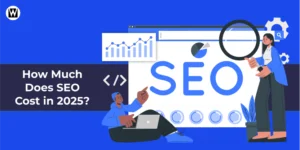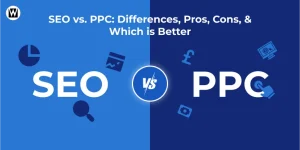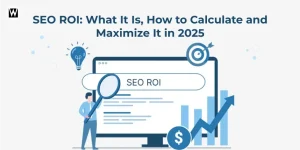SEO Checklist: 40+ Items to Review at One Glance
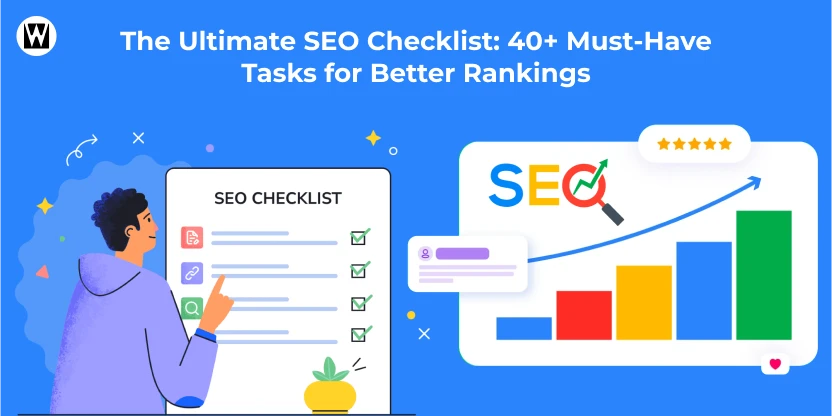
SEO is far from being a simple, one-step process. It’s a multifaceted strategy involving various tasks, from keyword research and content optimization to technical adjustments and link building.
For beginners, the sheer volume of tasks and the complexity of it all can feel overwhelming. It’s easy to get lost in the details or feel like you’re constantly chasing after new updates and algorithm changes. But don’t worry — you’re not alone in this!
That’s why we’ve put together this beginner-friendly SEO checklist. We’ve simplified the essentials so you can focus on what matters and start seeing results without feeling stressed. Let’s dive in and get your website on the path to success!
How to Use This SEO Checklist?
To help you make the most of this SEO checklist, we’ve divided it into key sections that cover the core principles of SEO. These include SEO Basics, Keyword Research, On-Page SEO, Content, Technical SEO, and Link Building. By breaking things down this way, we’ve made it easier for you to focus on the areas that matter most to your website’s needs.
- New to SEO? Start with the SEO Basics, Keyword Research, and On-Page SEO to build a solid foundation.
- Content not driving traffic? Focus on the Content Checklist to refine your strategy and improve engagement.
- Site slow or experiencing technical issues? Use the Technical SEO Checklist to fix performance problems and optimize site health.
- Experienced with SEO but want more traffic? Dive into the Link Building Checklist to boost your organic reach.
- Boost SEO with social media? Optimize profiles, share SEO-friendly content, and encourage engagement to drive traffic.
- Optimizing for voice search? Focus on long-tail keywords, featured snippets, and local SEO for better voice search visibility.
- Streamline SEO with AI? Leverage AI tools for keyword research, content optimization, and automated audits to save time and improve results.
By following this approach, you’ll be able to focus on what’s most important for your site and make measurable improvements over time.
SEO Basic Checklist
When starting with SEO, focusing on the basics is essential for laying a solid foundation for long-term success. By tackling these fundamental tasks, you’ll ensure that your site is optimized properly for search engines, making it easier to rank and attract traffic. Let’s break down the crucial steps in this SEO Basics Checklist.
1. Set Up Google Search Console
Google Search Console is a free tool that helps you monitor and improve your website’s performance in search results. It allows you to track your site’s search traffic, fix issues, and understand how Google crawls and indexes your pages.
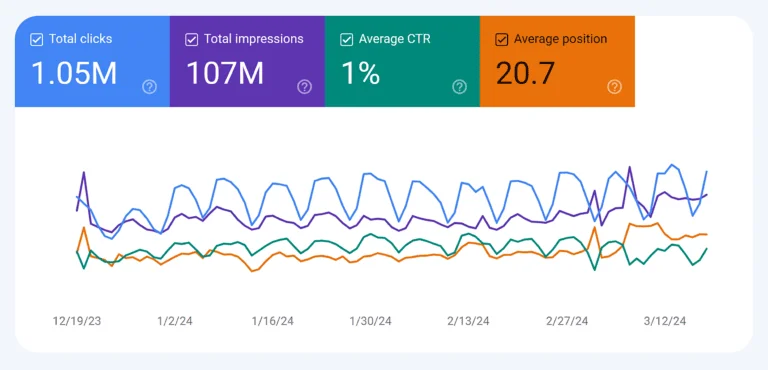
Steps to Set Up Google Search Console:
- Go to Google Search Console and log in with your Google account.
- Add your website and verify ownership through methods like adding a meta tag to your website or using Google Analytics.
- Once verified, monitor clicks, impressions, and performance data to improve your SEO strategy.
2. Install Google Analytics
Google Analytics provides valuable insights into who visits your website, what pages they visit, and how they interact with your content. This information is crucial for understanding your audience and optimizing your site based on real data.
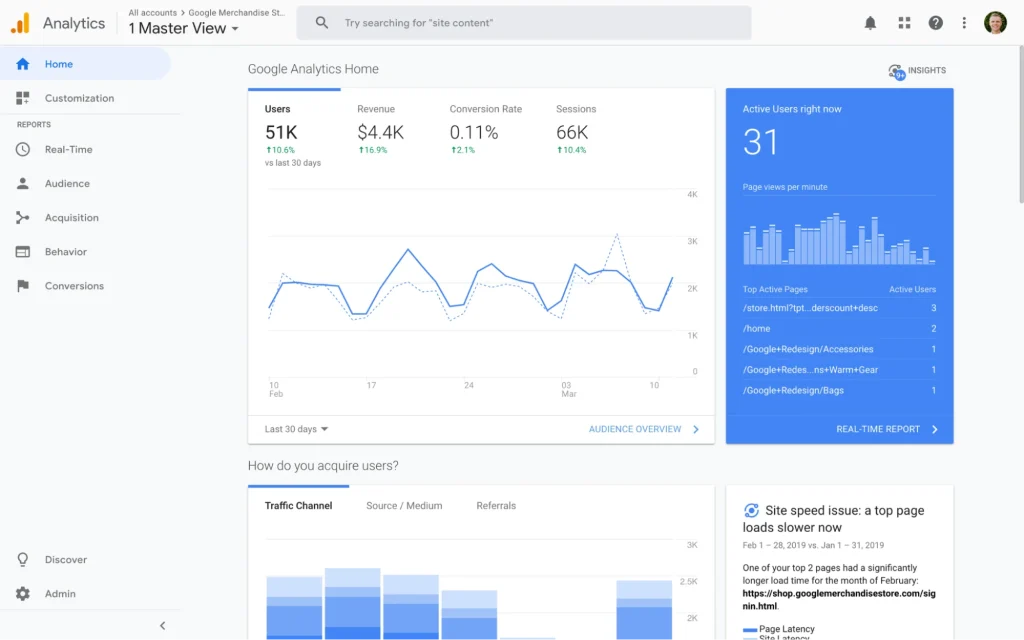
- Sign up for Google Analytics at Google Analytics.
- Add the tracking code to your website (or use a plugin if you’re on WordPress).
- Start analyzing visitor behavior to uncover SEO trends, traffic sources, and areas for improvement.
3. Perform Competitor Research
Understanding what your competitors are doing in SEO is key to identifying opportunities and gaps in your strategy. Competitor research helps you stay ahead of the curve and refine your approach to SEO.
- Identify key competitors in your niche by searching for your target keywords and reviewing top-ranking pages.
- Use tools like SEMrush, Ahrefs, or Moz to analyze your competitors’ backlinks, top-performing content, and keyword strategies.
- Look for patterns in their content, keywords, and overall SEO strategies to replicate successful tactics.
4. Optimize Your Site’s URL Structure
Search engines prefer clean and descriptive URLs. A simple, well-structured URL helps both users and search engines understand what the page is about.
Example:
- Good: www.example.com/seo-services
- Bad: www.example.com/page?id=12345
Keep URLs short, clear, and relevant to the page content, incorporating target keywords when possible.
5. Create a Robots.txt File
A robots.txt file instructs search engines on which pages to crawl and which to ignore. It’s an important tool for controlling your site’s indexing and preventing unnecessary pages from being crawled.
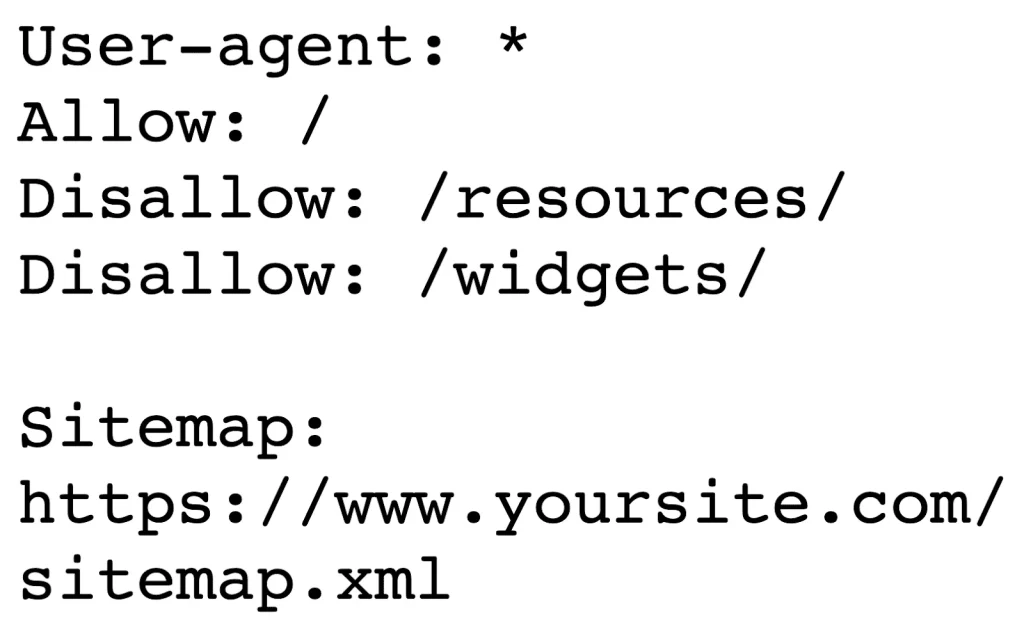
Steps to Create a Robots.txt File:
- Use a simple text editor to create the file with directives like User-agent: * and Disallow: /private-page/.
- Upload the file to the root directory of your site, ensuring it’s accessible at www.example.com/robots.txt.
6. Submit Your Sitemap to Google
A sitemap is a file that lists all the pages on your site, making it easier for search engines to crawl and index your content. Submitting a sitemap to Google ensures that all your important pages are discovered.
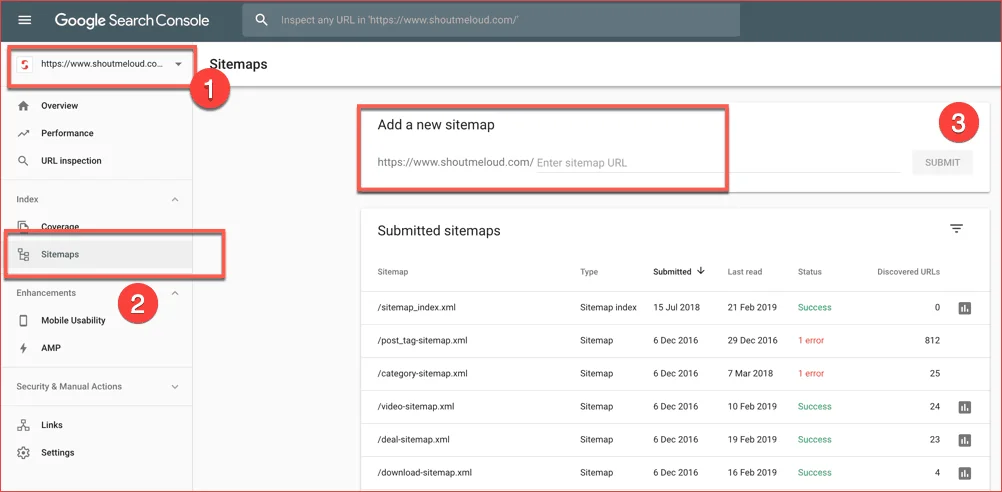
Steps to Submit Your Sitemap:
- Use plugins like Yoast SEO (for WordPress), RankMath SEO or manually create an XML sitemap.
- Go to Google Search Console and submit your sitemap URL under the Sitemaps section.
7. Consider SEO Tools for Better Analysis and Optimization
SEO tools provide in-depth insights into your website’s performance, helping you track rankings, identify issues, and optimize your content effectively. These tools can automate tedious tasks and save time.
Popular SEO Tools:
- SEMrush – A comprehensive tool for keyword research, site audits, and competitive analysis.
- Ahrefs – Known for its robust backlink analysis and site audit features.
- Moz – Offers tools for keyword tracking, on-page SEO, and link building.
- Yoast SEO – A WordPress plugin that helps optimize on-page content with SEO-friendly suggestions.
- Google Analytics & Search Console – Free tools from Google that offer insights on performance, traffic, and indexing.
8. Add Alt Text to Images
Alt-text helps search engines understand the content of your images and is also crucial for accessibility. Properly describing images can give your SEO a small but meaningful boost.
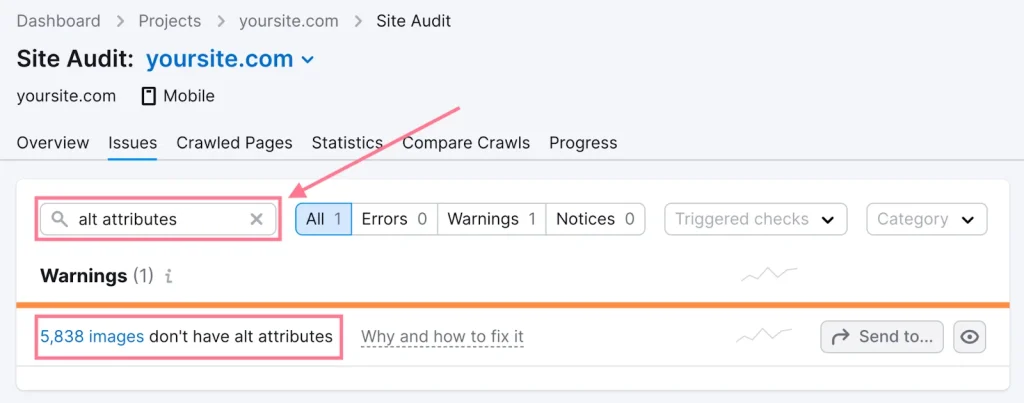
For instance,
- Good: <img src=”seo-checklist.jpg” alt=”SEO checklist for beginners”>
- Bad: <img src=”image1.jpg” alt=””>
Use descriptive alt text with relevant keywords where appropriate.
By following this SEO Basic Checklist, you’ll ensure that your website is set up for success. These foundational tasks will help you improve visibility, track performance, and make informed decisions to enhance your overall SEO strategy.
Keyword Research Checklist
Keyword research is the cornerstone of any effective SEO strategy. Without the right keywords, you risk targeting the wrong audience or missing out on valuable traffic. Let’s walk through the essential steps to help you find the best keywords to drive organic traffic to your site.
9. Brainstorm Initial Keyword Ideas
Start by thinking about the main topics and services your website offers. Put yourself in the shoes of your potential visitors and consider what phrases they might type into Google to find you.
Example:
If you run a digital marketing agency, some basic keyword ideas could be “digital marketing,” “SEO services,” or “online marketing strategies.”
10. Use Keyword Research Tools
Once you have a list of initial ideas, it’s time to dive deeper using keyword research tools. These tools help you uncover hidden keyword opportunities, estimate search volume, and analyze competition.
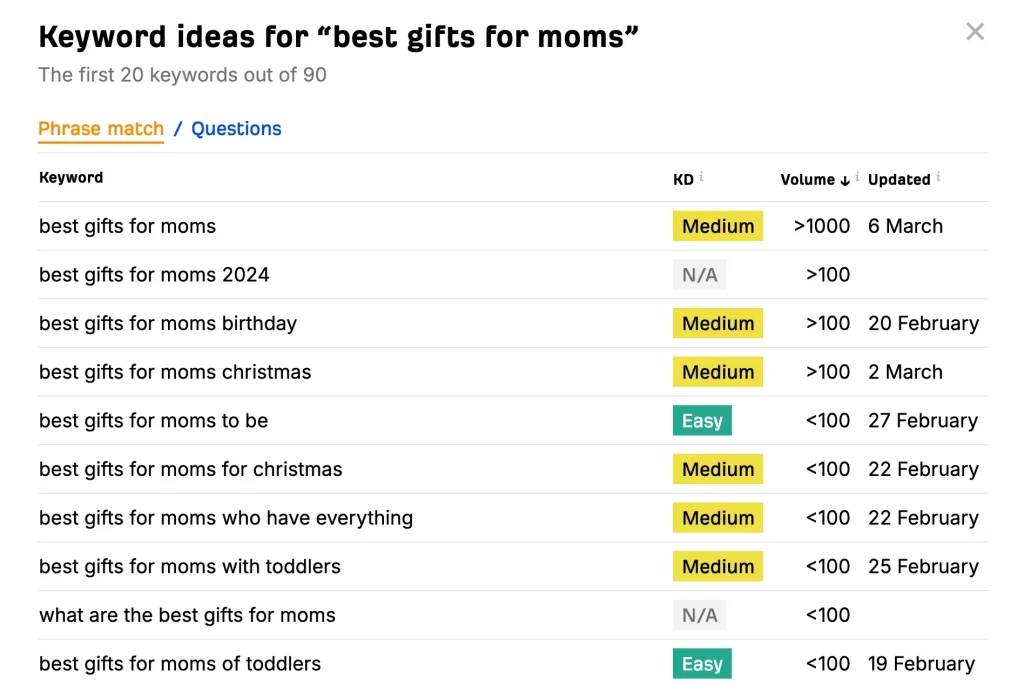
Popular Tools:
- SEMrush – Offers detailed keyword analysis, competition insights, and trends.
- Google Keyword Planner – A free tool that provides keyword ideas and search volume based on Google Ads data.
- Ahrefs – Known for keyword difficulty scoring and discovering long-tail keywords.
- Ubersuggest – A budget-friendly tool that offers keyword suggestions and SEO insights.
11. Check Search Volume and Competition
Now that you have a list of potential keywords, analyze their search volume (how often they’re searched) and competition (how many other sites are targeting the same keyword). Aim for a balance between high volume and low competition.
Tip:
Long-tail keywords (phrases with 3 or more words) often have lower competition and can bring more targeted traffic. For example, instead of just “SEO,” try “best SEO services for small businesses.”
12. Analyze Search Intent
Understanding the intent behind a keyword is crucial. Are people searching for information, products, or services? This is known as search intent, and matching your content to the right intent can boost your chances of ranking.
Types of Search Intent:
- Informational: Users want to learn something (e.g., “How to do keyword research”).
- Navigational: Users want to visit a specific website (e.g., “Facebook login”).
- Transactional: Users are ready to make a purchase or sign up (e.g., “buy SEO services”).
Make sure your content aligns with the user’s intent to meet their needs and improve rankings.
13. Analyze Competitor Keywords
Take a look at your competitors and see which keywords they are targeting. This can give you valuable insights into keywords that might be missing from your strategy or keywords you can improve upon.
How to Analyze Competitor Keywords:
- Use SEMrush or Ahrefs to uncover which keywords your competitors are ranking for.
- Identify keywords with moderate competition that you can realistically rank for.
14. Consider Keyword Relevance to Your Content
The keywords you target must be highly relevant to your content and business. Ranking for irrelevant keywords may bring traffic, but it won’t lead to conversions.
For example, if your website sells handmade furniture, targeting a keyword like “buy office chairs” may not be as effective as “handmade wooden furniture for living rooms.”
15. Use Keyword Variations and Synonyms
Google’s algorithm is smart—it understands variations and synonyms of your target keywords. Instead of targeting the same keyword repeatedly, use different variations to create a natural, engaging flow in your content.
If your target keyword is “SEO services,” you can also use variations like “SEO optimization,” “SEO experts,” or “search engine optimization services” in your content.
16. Prioritize Long-Tail Keywords
Long-tail keywords are more specific phrases that often have lower competition and higher conversion rates. These keywords usually indicate users who are further along in their buyer’s journey and are ready to take action.
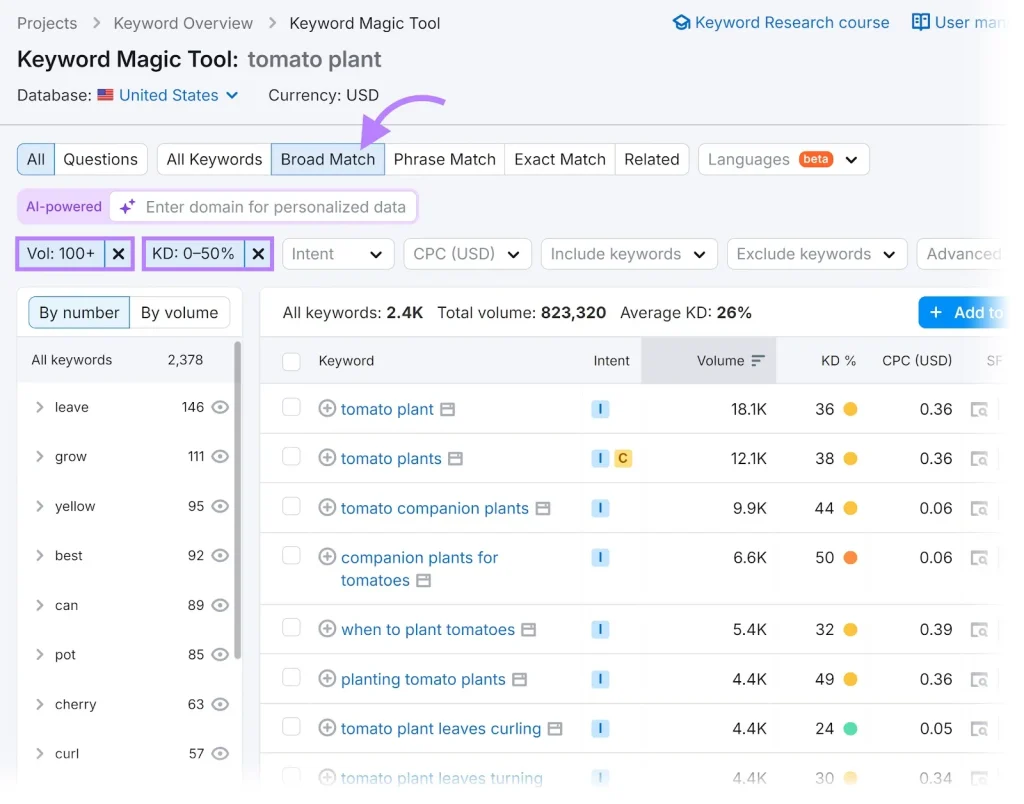
Instead of targeting a broad keyword like “SEO,” target long-tail phrases like “affordable SEO services for small businesses” or “SEO experts for local businesses.”
17. Track Keyword Performance
After you’ve chosen your target keywords, it’s crucial to track their performance over time. Keyword rankings can fluctuate, and it’s essential to adjust your strategy as needed to maintain or improve your rankings.
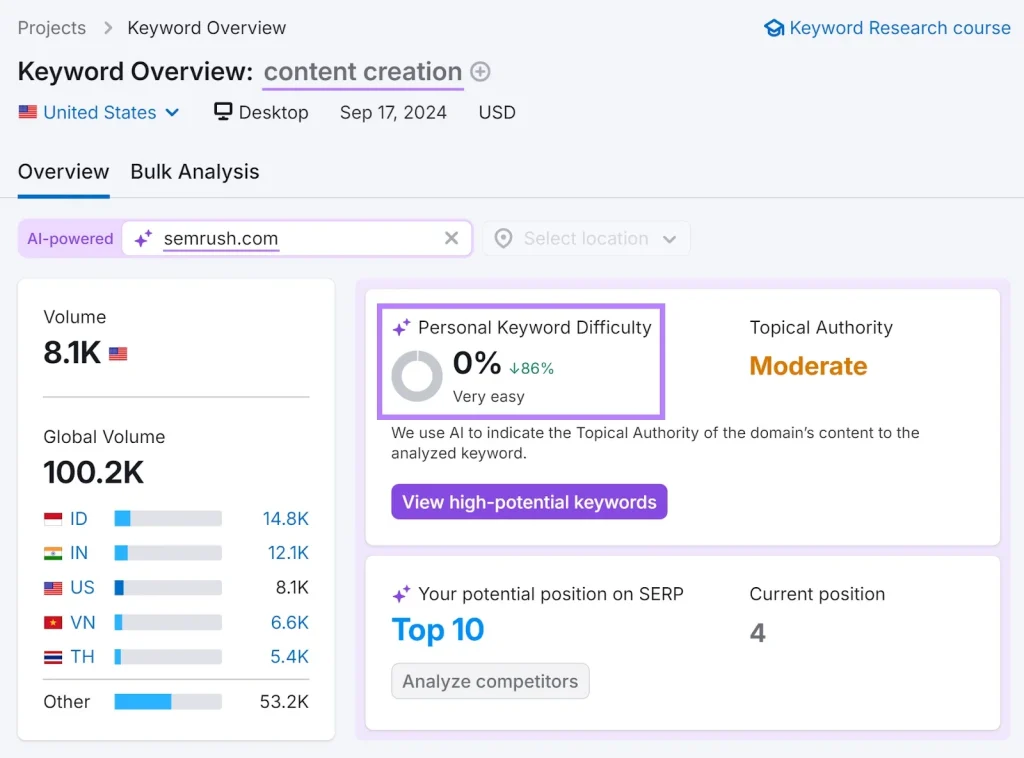
By following this keyword research checklist, you’ll ensure that your content is targeting the right audience with the most effective keywords. Remember, successful keyword research is an ongoing process, so continue to refine and optimize your strategy to stay ahead of the competition.
Pro Tip: Regularly check your rankings using tools like Google Search Console or Rank Tracker to monitor progress and identify areas for improvement.
On-page SEO Checklist
On-page SEO is all about optimizing the content and structure of your website to improve its visibility and relevance for search engines. Getting these elements right is crucial for ranking well and providing a better user experience.
18. Optimize Title Tags
Title tags are one of the most important on-page SEO elements. They tell both search engines and users what your page is about. Make sure each title tag is unique, includes your target keyword, and is enticing enough for users to click on.
Tip: Keep title tags under 60 characters to ensure they’re fully displayed in search results.
Example:
- Good: “SEO Services for Small Businesses | Boost Your Rankings Today”
- Bad: “SEO Services”
19. Craft Compelling Meta Descriptions
Meta descriptions appear under your title in search results and give users a preview of your content. While not a direct ranking factor, a well-written meta description can increase your click-through rate (CTR) and drive more traffic.
Tip: Write meta descriptions under 160 characters, making them actionable and relevant to the page content.
Example:
- Good: “Get top-notch SEO services for small businesses. Increase visibility and drive more organic traffic with proven SEO strategies.”
- Bad: “We offer SEO services.”
20. Use Header Tags (H1, H2, H3, etc.)
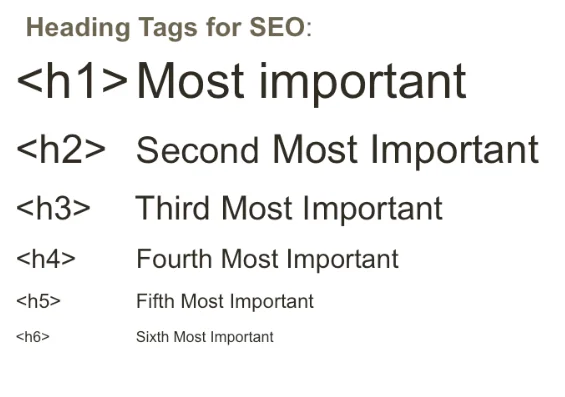
Header tags (H1, H2, H3, etc.) organize your content for better readability and help search engines understand the structure of your page. Your main title should be an H1, and subsequent sections should use H2 or H3 tags to break up the content.
Tip: Use only one H1 tag per page (usually for the main title) and include relevant keywords in H2/H3 tags.
21. Optimize URL Structure
A clean and descriptive URL structure makes it easier for both search engines and users to understand what a page is about. Keep your URLs simple, short, and keyword-rich.
Example:
- Good: www.example.com/seo-services
- Bad: www.example.com/page?id=123
22. Include Target Keywords Naturally in Content
Integrating your target keywords naturally throughout the page content is essential. However, avoid keyword stuffing, which can hurt your rankings. Focus on readability and user experience first, while including keywords where they make sense.
Tip: Aim for a keyword density of 1-2% to avoid over-optimization. |
23. Use Internal Linking
Internal links connect different pages on your site and help search engines crawl and index your content more efficiently. They also improve navigation and encourage users to explore more of your site.
Tip: Link to relevant pages within your website’s content, especially high-authority pages, to distribute page authority.
Example:
- “Check out our SEO services page for more details.”
24. Optimize for Featured Snippets
Featured snippets are the boxed answers that appear at the top of some search results. To optimize for these, aim to answer specific questions clearly and concisely within your content.
Tip: Use bullet points, numbered lists, or direct answers to questions to increase your chances of being selected for a featured snippet.
Example:
- Question: “What is SEO?”
- Answer: “SEO (Search Engine Optimization) is the process of improving your website’s visibility in search engine results through targeted strategies.”
25. Optimize Images with Alt Text
Images play an important role in user experience, but they also need to be optimized for SEO. Adding alt text (alternative text) to your images allows search engines to understand the content and context of the images, improving your rankings for image searches.
Tip: Use descriptive alt text that includes relevant keywords and provides context for the image.
Example:
- Good: <img src=”seo-checklist.jpg” alt=”SEO checklist for beginners”>
- Bad: <img src=”image1.jpg” alt=””>
26. Improve Content Quality and Readability
High-quality, user-friendly content is a critical part of on-page SEO. Ensure your content provides value, is well-written, and answers the user’s query. The easier your content is to read, the more likely visitors are to stay on your page.
Tip: Use tools like Hemingway Editor or Grammarly to check for readability and grammar errors.
Example:
- Use short paragraphs, bullet points, and subheadings to make your content scannable.
27. Implement Schema Markup
Schema Markup is a code that you add to your website to help search engines understand your content better. It can enhance your search results with rich snippets, such as star ratings, prices, and product availability.
Tip: Use tools like Google’s Structured Data Markup Helper to implement schema on your site easily.
Remember, on-page SEO is an ongoing process—regularly audit and update your content to stay competitive and keep improving your rankings.
Content Checklist
Creating high-quality content that resonates with your audience is key to driving traffic, building authority, and ranking well in search engines. This content checklist focuses on the most important elements you need to consider when crafting your content.
28. Focus on High-Quality, Relevant Content
Quality content should provide real value to your audience. Your content should answer questions, solve problems, or provide in-depth insights that your readers can’t find elsewhere. A good starting point is to understand your target audience and the questions they are asking.
- Conduct keyword research to understand what topics are trending and what your audience is searching for.
- Use Google Trends or tools like BuzzSumo to identify popular topics within your niche.
- Create detailed, well-researched content that addresses your audience’s pain points and provides actionable solutions.
If you’re in the digital marketing niche, a high-quality piece might be an in-depth guide on “How to Boost Organic Traffic with SEO.” This content should be thoroughly researched, regularly updated, and answer all possible questions someone might have about the topic.
29. Incorporate Multimedia Elements to Enhance Engagement
To keep readers engaged and enhance your SEO, multimedia elements like images, infographics, charts, and videos are key. Visual content not only improves user engagement but also helps communicate complex ideas more clearly.
We recommend using these forms of multimedia in your content where you can:
- Images: Use images to break up large blocks of text and make your content more digestible. Ensure images are relevant and have optimized alt text.
- Charts: Use charts to present data clearly, especially if you’re discussing statistics or trends.
- Infographics: Infographics can simplify complex information into a visually appealing format that’s easy to understand and share.
- Videos: Include videos to explain key concepts, give tutorials, or share case studies.
- Interactive Polls and Quizzes: Add a fun and engaging element to your content by incorporating polls and quizzes, which also encourage user interaction.
Tools to Use:
- Canva: Great for creating eye-catching infographics and images.
- Lumen5: A tool that helps you create videos from existing blog posts.
- SurveyMonkey: A popular tool for creating interactive polls and quizzes.
30. Optimize Content for SEO Without Overstuffing Keywords
While it’s important to include your target keywords, remember that keyword stuffing is a thing of the past. Your content should flow naturally and include relevant keywords in a way that doesn’t disrupt readability. You also want to include related terms (LSI keywords) to increase your content’s reach.
What to Do:
- Include your target keyword in the title, URL, meta description, and naturally throughout the content.
- Use LSI (Latent Semantic Indexing) keywords to diversify your keyword strategy. LSI keywords are closely related to your main keyword but are semantically varied.
- Aim for 1-2% keyword density, ensuring that your content sounds natural while still being optimized.
Tools to Use:
- Yoast SEO (for WordPress): A plugin that helps you optimize content by suggesting keyword density and readability improvements.
- LSI Graph: This tool helps you find related keywords and synonyms to enhance the SEO of your content.
If your main keyword is “SEO for beginners,” you might use LSI keywords like “SEO tips,” “beginner SEO guide,” or “how to improve SEO” throughout the content.
31. Ensure Content Is Scannable and Readable
Your content must be easy to scan. Readers often skim through content before diving deeper, so making it scannable improves both user experience and SEO. Using short paragraphs, subheadings, and bulleted lists can enhance readability.
What to Do:
- Use short paragraphs (2-3 sentences max) to make your content easier to read.
- Break up the text with subheadings (H2, H3 tags) to organize your content into easily digestible sections.
- Use bullet points or numbered lists to highlight key points or actionable tips.
- Keep sentences concise and avoid jargon.
Instead of writing a long block of text, break your information into a bulleted list of actionable steps. This makes it much easier for readers to grasp and follow your advice quickly.
Off-page SEO Checklist
Off-page SEO focuses on activities outside your website that help improve its authority, trustworthiness, and visibility in search engines. These activities include building high-quality backlinks, managing your online reputation, and optimizing your presence on social media.
32. Build High-Quality Backlinks
Backlinks are one of the most important factors for SEO, as they signal to search engines that other sites consider your content valuable and trustworthy. The more high-quality backlinks you acquire from authoritative websites, the more likely your site is to rank higher on search engine results pages (SERPs).
- Focus on acquiring backlinks from high-authority, relevant sites within your niche.
- Create shareable content like infographics, comprehensive guides, or case studies that encourage others to link back to your site.
- Build relationships with industry influencers and bloggers who may link to your content.
- Guest blogging is a great way to generate backlinks and increase exposure to a new audience.
If you run a digital marketing agency, guest blogging on reputable sites like Neil Patel’s blog or Moz’s blog will help you build valuable backlinks while boosting your credibility in the industry.
33. Engage in Social Media Marketing
While social media signals don’t directly impact rankings, they are an essential part of off-page SEO. A strong social media presence increases brand visibility, drives traffic to your site, and encourages social sharing, which can indirectly improve SEO by creating more opportunities for backlinks.
- Create engaging and shareable content that encourages users to interact with your brand on social media platforms such as Facebook, Twitter, LinkedIn, and Instagram.
- Use hashtags strategically to increase visibility.
- Engage with followers regularly, respond to comments, and join relevant conversations.
- Share your blog posts, case studies, videos, and infographics to drive traffic to your site.
Tools to Use:
- Buffer or Hootsuite: These tools help schedule and manage your social media posts.
- BuzzSumo: Discover trending topics and top-performing content to guide your social media strategy.
For instance, when you post a blog article on Facebook, and it gets shared by your followers, it increases your brand’s visibility. Additionally, if the content is valuable, other sites may link to it, indirectly boosting your SEO.
34. Land Google’s Knowledge Panel
The Knowledge Panel is a box that appears on the right-hand side of Google’s search results when someone searches for a well-known brand, person, or organization. While it’s different from your Google Business Profile, optimizing your online presence—especially through Business Profile—can help trigger a Knowledge Panel for your business over time.
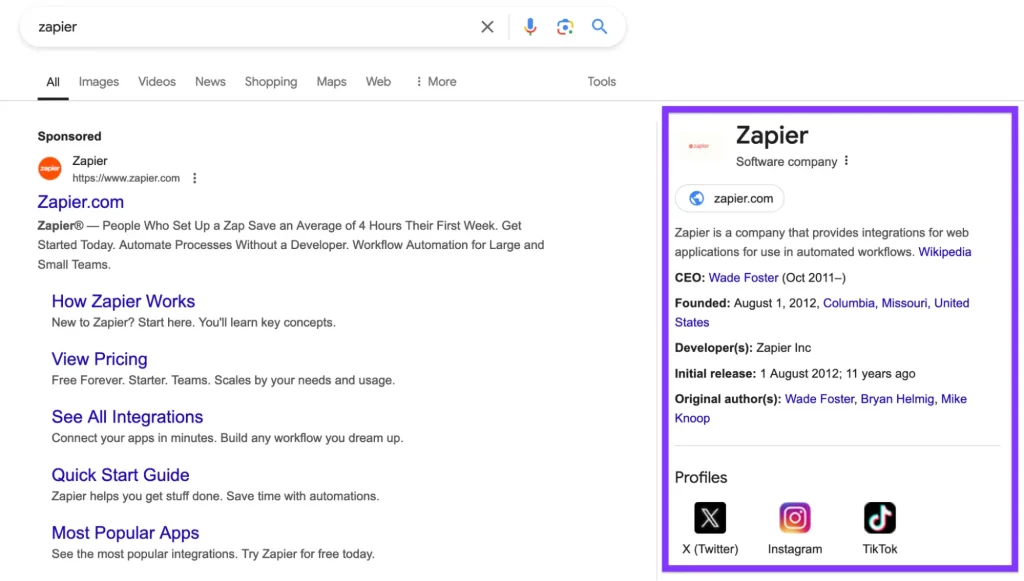
What to Do:
- Claim and optimize your Google Business Profile (GBP): For local businesses, this is a critical first step.
- Make sure all fields are filled out—business name, address, phone number, website, hours, and a solid description.
- Build citations (mentions of your business) on high-authority directories and third-party websites like Yelp, Yellow Pages, or industry-specific sites.
- Maintain an active online presence with a verified social media profile. Google is more likely to pull information from credible and consistent sources.
- Encourage Google reviews and maintain a strong reputation online. This reinforces credibility in Google’s eyes.
- Get featured on high-authority websites—such as local news sites, business directories, and Wikipedia if applicable—to improve your brand’s visibility and recognition.
While both Knowledge Panels and Google Business Profiles (formerly Google My Business) appear on the right side of Google search results, they serve different purposes.
Knowledge Panels are automatically generated by Google and act as comprehensive information hubs about entities such as people, places, and organizations.
In contrast, Google Business Profiles are specifically designed for local businesses to manage and control their online presence, including contact details, hours, reviews, and more.
If you own a restaurant, for example, setting up and optimizing your Google Business Profile helps Google pull accurate information—like your menu, hours, and photos—that may be used in the Knowledge Panel when users search for your restaurant name.
💡 Note: You can’t directly apply for a Knowledge Panel. Google generates it automatically based on structured data, online mentions, and trusted sources. However, by optimizing your business presence, building brand authority, and ensuring consistent information across the web, you increase your chances of being featured.
35. Influencer Outreach and Relationship Building
Collaborating with influencers and industry leaders can have a positive impact on your off-page SEO. Influencers can help promote your content, products, and services to a broader audience, increasing brand awareness and trust. Additionally, their endorsement can lead to high-quality backlinks.
- Identify relevant influencers in your industry using tools like BuzzSumo or Followerwonk.
- In addition to using tools, consider reaching out directly to influencers who are popular in your local community via social media.
- Reach out to influencers with personalized, compelling pitches. Offer them valuable content, products, or services in exchange for their endorsement or link.
- Build long-term relationships by engaging with influencers on social media and commenting on their content.
If you sell fitness equipment, partnering with a fitness influencer who regularly posts workout videos can help you reach a targeted audience and increase exposure. They might link to your product pages or mention your brand, driving more traffic and potential backlinks.
36. Manage Online Reviews and Reputation
Your online reputation plays a critical role in off-page SEO. Positive reviews signal trustworthiness and authority to search engines, while negative reviews can harm your credibility. Managing reviews on platforms like Google, Yelp, and Trustpilot is crucial for your brand’s reputation.
If you own a hotel and a guest leaves a glowing review on TripAdvisor, respond to their review to show appreciation. A combination of positive reviews and your active response boosts your reputation and contributes to local SEO rankings.
Link Building Checklist
Link building remains one of the most powerful off-page SEO techniques. Acquiring high-quality backlinks not only improves your site’s authority but also drives organic traffic and helps your site rank higher in search engine results.
37. Create Shareable, High-Quality Content
The cornerstone of any successful link-building strategy is creating content that people naturally want to link to. When your content provides real value, others will want to share it. The more useful, informative, or entertaining your content is, the more likely it will earn organic backlinks. This is where content marketing comes into play.
- Focus on creating in-depth guides, how-to tutorials, case studies, and research-based content.
- Make sure your content solves a problem, answers a question, or provides a unique perspective.
- Include visuals like infographics, charts, and videos to make your content more engaging.
HubSpot, a marketing and sales software company, excels in this area. They consistently creates valuable content, such as comprehensive guides and industry reports, which attract backlinks from leading websites like Forbes and Moz.
38. Guest Blogging
Guest blogging is a proven method of gaining backlinks while also establishing your brand authority in your niche. By writing for other websites, you can reach a new audience and earn backlinks that point back to your site.
For instance, Neil Patel, a well-known digital marketer, frequently writes guest posts on websites like Entrepreneur and Social Media Examiner. His guest posts often link back to his blog or products, helping him build a strong backlink profile.
39. Leverage Influencer Marketing for Backlinks
Partnering with influencers in your industry can help you earn backlinks from their website or social media platforms. Influencers have strong online followings, and their endorsement can drive traffic to your site as well as attract valuable backlinks.
- Identify influencers who align with your brand values and have a following that matches your target audience.
- Reach out with an offer to collaborate, such as providing a product sample, co-authoring a blog post, or promoting each other’s content.
Glossier, a beauty brand, has leveraged influencer marketing to build backlinks. By working with beauty influencers, Glossier has gained mentions and backlinks from high-authority beauty and lifestyle blogs, which has boosted its visibility and authority.
40. Create Resource Pages and Linkable Assets
Another effective strategy is to create resource pages or linkable assets that others can refer to. This could include tools, templates, checklists, or comprehensive guides. When others find these resources useful, they are more likely to link back to them.
What to Do:
- Build resource pages, such as toolkits, lists of industry resources, or ultimate guides on relevant topics.
- Promote these resources through outreach campaigns to let others know about your valuable content.
Moz has a famous “Beginner’s Guide to SEO,” which has been linked by hundreds of authoritative websites. This resource serves as a long-lasting link-building asset that continues to generate backlinks over time.
AI-Driven SEO Checklist
AI has revolutionized SEO by automating complex tasks, providing deeper insights, and enhancing the overall optimization process.
41. AI for Content Creation and Optimization
AI algorithms help you generate high-quality content faster, making it easier to optimize for SEO. AI-driven tools analyze top-ranking content to identify the keywords, tone, and structure that will work best for your target audience.
- AI Tools: Jasper, Copy.ai, MarketMuse, Frase.io
- Impact: Produces SEO-friendly content that ranks higher and engages users, saving time on writing and content planning.
42. On-Page SEO Optimization with AI
AI tools can audit your website’s on-page SEO, suggesting improvements in areas like keyword density, meta tags, headings, and internal linking structure. This ensures your content is fully optimized and aligns with SEO best practices.
- AI Tools: Clearscope, SurferSEO
- Impact: Improved on-page optimization with actionable insights for better rankings.
43. AI Overview Results in Google SERP
AI has significantly transformed how results are displayed on Google’s Search Engine Results Pages (SERP). With advancements like RankBrain, BERT, and MUM, Google now uses AI to better understand search intent and provide more relevant results to users.

- Focus on creating high-quality, in-depth content that addresses user intent, not just keywords. Google’s AI updates prioritize content that provides comprehensive, valuable answers to questions.
- Optimize for Featured Snippets and People Also Ask boxes, which are heavily influenced by AI’s ability to understand user queries in more context.
If you search “how to bake a cake” on Google, you may notice Google’s Featured Snippet shows a direct answer to your query, often accompanied by a list or step-by-step instructions. This is the result of AI algorithms understanding that users prefer concise and actionable information. To rank in these positions, content creators must ensure their posts directly address the searcher’s intent with clear, structured data.
Advanced SEO Tips to Boost Your Rankings
To truly elevate your SEO efforts and stand out from the competition, it’s essential to go beyond the basics. Here are some advanced SEO tips that can help you push your website’s rankings higher, ensuring it receives the attention it deserves.
- Align content with the specific needs behind a search query to rank higher.
- Use structured data to help search engines understand your content better.
- Organize your website logically to help crawlers navigate and index it easily.
- Prioritize page speed and user interaction to enhance user experience.
- Leverage AI-powered analytics tools for data-driven SEO improvements.
- Focus on acquiring relevant backlinks from reputable sources.
- Build content that demonstrates expertise, authority, and trustworthiness.
- Incorporate videos, infographics, and other media to attract diverse audiences.
- Optimize your Google My Business profile and local keywords for better local rankings.
- Regularly check your competitors’ strategies to uncover new opportunities.
Want to implement these advanced techniques? Consider professional SEO services to take your strategy to the next level.
Get Started with WebyKing’s SEO Services Today and Boost Your Online Presence!
SEO is an ongoing process, and while the checklists above can guide beginners, it’s easy to feel overwhelmed with the constantly evolving landscape. If you’re unsure where to start or which strategies will work best for your business, WebyKing’s expert team is here to help. With over 10 years of experience in delivering results, we’ve successfully helped businesses boost their traffic, improve their rankings, and increase revenue.
Contact us today to discuss how we can improve your website’s performance and drive sustainable growth for your business!
FAQs on Ultimate SEO Checklist for 2025
What is an SEO checklist, and why is it important?
An SEO checklist is a structured guide outlining essential tasks to optimize a website for search engines. It ensures that all critical aspects of SEO are addressed, helping improve visibility, traffic, and rankings.
How often should I update my SEO checklist?
It’s advisable to review and update your SEO checklist at least quarterly. Search engine algorithms and best practices evolve, so regular updates ensure your strategies remain effective.
What are the key components of an effective SEO checklist?
An effective SEO checklist typically includes keyword research, on-page optimization, technical SEO, content creation, link building, and performance monitoring.
How does technical SEO differ from on-page SEO?
Technical SEO focuses on website infrastructure, such as site speed, mobile-friendliness, and crawlability. On-page SEO deals with content elements like meta tags, headings, and keyword usage.
Can following an SEO checklist improve my website's ranking?
Yes, adhering to a comprehensive SEO checklist helps ensure that your website meets search engine criteria, which can lead to improved rankings and increased organic traffic.
Are there tools to help implement an SEO checklist?
Yes, tools like Google Search Console, SEMrush, Ahrefs, and Yoast SEO can assist in executing various tasks outlined in an SEO checklist, providing insights and recommendations.

Ravi Makhija, the visionary Founder and CEO of WebyKing, is a seasoned digital marketing strategist and web technology expert with over a decade of experience. Under his leadership, WebyKing has evolved into a premier full service web and marketing agency, delivering innovative solutions that drive online success. Ravi’s deep understanding of the digital landscape combined with his passion for cutting-edge technologies empowers him to consistently exceed client expectations and deliver results that matter.

